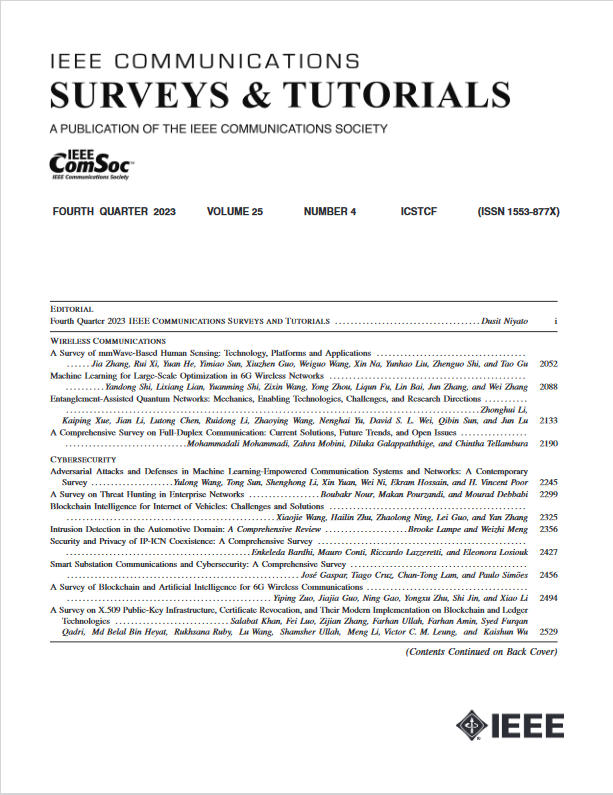Artificial Intelligence-Based Cybersecurity for the Metaverse: Research Challenges and Opportunities
IF 34.4
1区 计算机科学
Q1 COMPUTER SCIENCE, INFORMATION SYSTEMS
引用次数: 0
Abstract
The metaverse, known as the next-generation 3D Internet, represents virtual environments that mirror the physical world. It is supported by innovative technologies such as digital twins and extended reality (XR), which elevate user experiences across various fields. However, the metaverse also introduces significant cybersecurity and privacy challenges that remain underexplored. Due to its complex multi-tech infrastructure, the metaverse requires sophisticated, automated, and intelligent cybersecurity measures to mitigate emerging threats effectively. Therefore, this paper is the first to explore Artificial Intelligence (AI)-driven cybersecurity techniques for the metaverse, examining academic and industrial perspectives. First, we provide an overview of the metaverse, presenting a detailed system model, diverse use cases, and insights into its current industrial status. We then present attack models and cybersecurity threats derived from the unique characteristics and technologies of the metaverse. Next, we review AI-driven cybersecurity solutions based on three critical aspects: User authentication, intrusion detection systems (IDS), and the security of digital assets, specifically for Blockchain and Non-fungible Tokens (NFTs). Finally, we highlight challenges and suggest future research opportunities to enhance metaverse security, privacy, and digital asset transactions.基于人工智能的元宇宙网络安全:研究挑战与机遇
虚拟世界被称为下一代3D互联网,它代表了反映现实世界的虚拟环境。它得到了数字孪生和扩展现实(XR)等创新技术的支持,这些技术可以提升各个领域的用户体验。然而,虚拟世界也带来了重大的网络安全和隐私挑战,这些挑战尚未得到充分探索。由于其复杂的多技术基础设施,元宇宙需要复杂、自动化和智能的网络安全措施来有效地缓解新出现的威胁。因此,本文首次探讨了人工智能(AI)驱动的网络安全技术,并从学术和工业角度进行了研究。首先,我们概述了元宇宙,展示了详细的系统模型、各种用例,以及对其当前工业状态的见解。然后,我们提出了来自虚拟世界独特特征和技术的攻击模型和网络安全威胁。接下来,我们将基于三个关键方面回顾人工智能驱动的网络安全解决方案:用户身份验证、入侵检测系统(IDS)和数字资产的安全性,特别是区块链和不可替代令牌(nft)。最后,我们强调了挑战,并提出了未来的研究机会,以增强虚拟世界的安全、隐私和数字资产交易。
本文章由计算机程序翻译,如有差异,请以英文原文为准。
求助全文
约1分钟内获得全文
求助全文
来源期刊

IEEE Communications Surveys and Tutorials
COMPUTER SCIENCE, INFORMATION SYSTEMS-TELECOMMUNICATIONS
CiteScore
80.20
自引率
2.50%
发文量
84
审稿时长
6 months
期刊介绍:
IEEE Communications Surveys & Tutorials is an online journal published by the IEEE Communications Society for tutorials and surveys covering all aspects of the communications field. Telecommunications technology is progressing at a rapid pace, and the IEEE Communications Society is committed to providing researchers and other professionals the information and tools to stay abreast. IEEE Communications Surveys and Tutorials focuses on integrating and adding understanding to the existing literature on communications, putting results in context. Whether searching for in-depth information about a familiar area or an introduction into a new area, IEEE Communications Surveys & Tutorials aims to be the premier source of peer-reviewed, comprehensive tutorials and surveys, and pointers to further sources. IEEE Communications Surveys & Tutorials publishes only articles exclusively written for IEEE Communications Surveys & Tutorials and go through a rigorous review process before their publication in the quarterly issues.
A tutorial article in the IEEE Communications Surveys & Tutorials should be designed to help the reader to become familiar with and learn something specific about a chosen topic. In contrast, the term survey, as applied here, is defined to mean a survey of the literature. A survey article in IEEE Communications Surveys & Tutorials should provide a comprehensive review of developments in a selected area, covering its development from its inception to its current state and beyond, and illustrating its development through liberal citations from the literature. Both tutorials and surveys should be tutorial in nature and should be written in a style comprehensible to readers outside the specialty of the article.
 求助内容:
求助内容: 应助结果提醒方式:
应助结果提醒方式:


